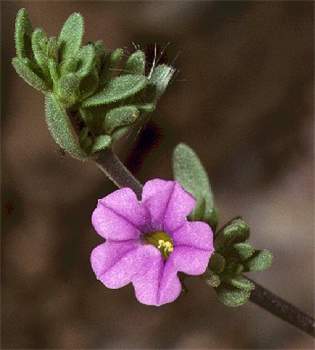Taxonomy
Calibrachoa La Llave & Lex., Nov. Veg. Descr. 2: 3 (1825)
Type species: C. procumbens La Llave & Lex.
Somewhat woody perennial herbs, pubescent with glandular hairs, viscid. Leaves alternate or upper ones paired, simple, entire, petiolate or sessile. Flowers solitary in leaf axils, bisexual, usually slightly zygomorphic. Calyx campanulate, deeply 5–lobed. Corolla single, funnel-shaped or salver-shaped, usually pink; limb shortly 5–lobed, the lobes conduplicate in bud. Stamens 5, 4 in two pairs, the 5th the shortest, inserted on corolla-tube; anthers bilocular, not cohering, versatile, dehiscing by longitudinal slits. Ovary bilocular; stigma capitate. Fruit a smooth capsule, opening from apex, enclosed by calyx. Seeds globular to angular.
A genus of c. 30 species mostly native to South America, especially Brazil. The genus is closely related to Petunia (see below), from which it has only relatively recently been split, and to Nicotiana from which it differs mainly in having solitary flowers and a base chromosome number of n=18 (Nicotiana n=12). One species naturalised in Australia; this species is commonly encountered in the horticultural trade.
D.E. Symon, The solanaceous genera, Browallia, Capsicum, Cestrum, Cyphomandra, Hyoscyamus, Lycopersicon, Nierembergia, Physalis, Petunia, Salpichroa and Withania, naturalised in Australia, J. Adelaide Bot. Gard. 3: 133–166 (1981); H.J.W.Wijsman, On the inter-relationships of certain species of Petunia: 6. New names for the species of Calibrachoa formerly included into Petunia (Solanaceae). Acta Bot. Neerl. 39: 101-102 (1990).
Changes since the Flora of Australia treatment
Specimens previously referred to as Petunia parviflora in the Flora of Australia treatment of 1981 are now usually to be found under the name Calibrachoa parviflora.
Opinions vary as to whether Calibrachoa and Petunia should be treated as distinct genera, Hunziker in his Genera of Solanaceae (2001) still absorbing Calibrachoa within Petunia. However the majority of publications now accept the two genera and support continues to grow. Recent DNA studies (T. Ando, H. Kokubun, H. Watanabe, N. Tanaka, T. Yukawa, G. Hashimoto, E. Marchesi, E. Suárez & I. L. Basualdo (2005). Phylogenetic analysis of Petunia sensu Jussieu (Solanaceae) using Chloroplast DNA RFLP. Ann. Bot. 96: 289-297.) provide further evidence for the split.
Calibrachoa species differ from Petunia by their woody stems and by their diploid chromosome number of 18 rather than 14. There are also differences in corolla aestivation (conduplicate in Calibrachoa, imbricate in Petunia) and in the walls of the cells of the seed coat (straight in Calibrachoa, wavy in Petunia).
Key to species
Only a single species is known in Australia, Calibrachoa parviflora (A.L.Juss.)D'Arcy.
